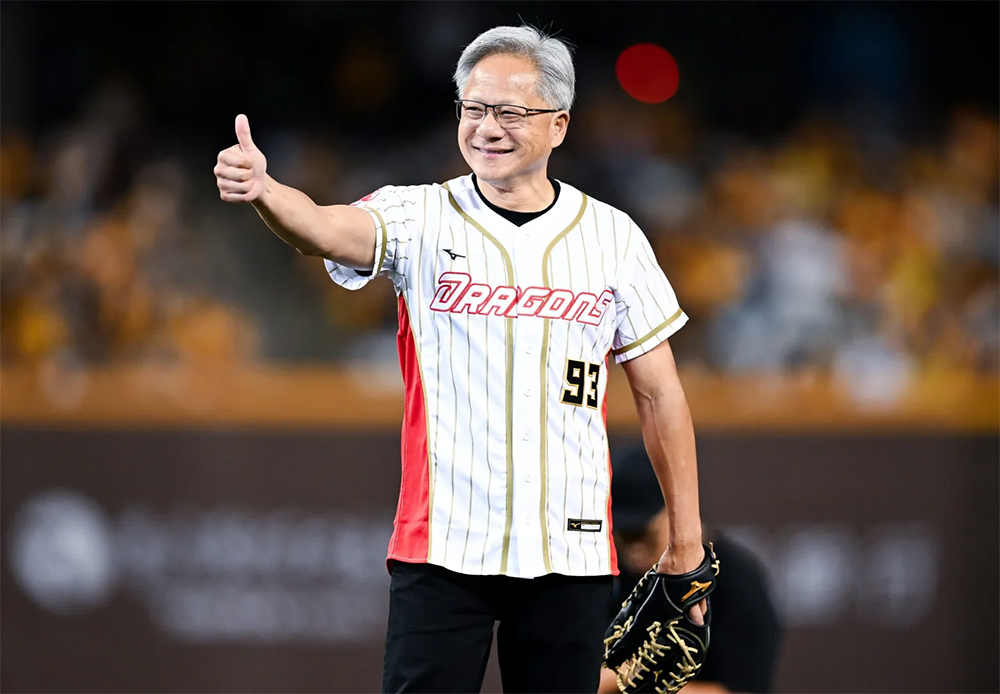
英伟达(Nvidia)副总裁西蒙娜·扬科夫斯基最近从市值高达3.1万亿美元的科技巨头离职,她对自己的上司和公司CEO黄仁勋表达了敬意。
在谈到她在这位白手起家的亿万富翁手下工作的经历时,她总结说:“与黄仁勋共事是让我终生难忘的一段经历。”
扬科夫斯基在该芯片制造商负责投资者关系和战略融资已近七年,她在LinkedIn上表示,黄仁勋“独树一帜”,然后她分享了从黄仁勋身上学到的三条领导经验:“第一性原理思维、零亿美元市场和光速执行。”
扬科夫斯基补充说:“他启发我要挑战极限,他会让我笑出眼泪,还让我学会了如何平衡工作与家庭。”
英伟达成为全球最有价值的公司,得益于黄仁勋的第一性原理思维和零亿美元市场理念
英伟达最初专注于为电脑游戏开发图形处理器,后来该公司发明了首批适用于人工智能的GPU,如今它已经成为市场主导者,市场上出售的70%以上的人工智能芯片来自该公司。
上周,英伟达曾短暂超过微软(Microsoft),以3.34万亿美元的市值成为全球最有价值的公司。
扬科夫斯基自豪地表示,自从她于2017年加入英伟达以来,她亲眼见证公司营收增长了10倍,利润和市值增长了超过20倍。
她补充说:“或许更了不起的是,英伟达旗舰GPU芯片的智算性能提高了1,000多倍,而尖端人工智能模型的规模扩大了20,000多倍。经历指数级增长是罕见且令人激动的过程,而且让我保持陡峭且令人兴奋的学习曲线。”
但英伟达在GPU领域的成功绝非偶然——它清晰地展示了黄仁勋的良好习惯,即用第一性原则思维(即质疑每一种假设以找到问题的基本要素)找到创新解决方案而不是模仿现有的模式,并在零亿美元市场(即新兴但潜力巨大的市场)发展业务。
之前,诞生于上世纪50年代的CPU作为最常用的计算机芯片,擅长逐个执行复杂的计算,但到了2010年代,随着深度学习和人工智能研究的增多,CPU已经无法满足数据科学家们的需求。
而GPU可以一次处理多个简单的计算,且事实证明,对于人工智能开发者创建和训练大语言模型所需要的计算系统,英伟达的GPU是最佳选择。
半导体资深研究分析师特里斯坦·杰拉对《财富》杂志表示:“黄仁勋富有远见,他很早就预见到GPU在数据中心的应用趋势,并根据这个愿景调整了公司的策略。”
英伟达富有远见的举措之一是,在2007年开发出一款高性能编程工具CUDA,可以简单的方式发挥其GPU的全部能力。
CUDA目前应用广泛,以至于开发大语言模型的公司,例如OpenAI的ChatGPT等,很难考虑使用其他技术。
正如黄仁勋之前所说的那样,这就是在零亿美元市场运营的意义所在。
上个月,他在接受Stripe的CEO帕特里克·克里森采访时表示:“我们的使命是去做没有人做过的事情,这些事情可能困难重重,但只要你能做到,就能做出真正的贡献。
这个市场在规模上可能是一个零亿美元市场,因为以前这个市场并不存在,我宁愿成为市场创造者,而不是市场接受者。”
西蒙娜·扬科夫斯基是谁?
扬科夫斯基毕业于斯坦福大学(Stanford University),在加入英伟达之前,一直任职于高盛(Goldman Sachs)。
但她透露,早在高盛工作期间,她与该芯片制造商之间就已经有非常密切的合作。
她在LinkedIn上发帖解释称:“在2001年,作为高盛一名新手股权研究分析师,我的第一个任务就是创建NVDA财务模型。在我们的初期研究过程中,我接触到了黄仁勋。”
她说道,她跟进了英伟达“炫酷的产品发布、飞快的技术进步、前往中国台湾的供应链考察”以及“对黄仁勋的问答”,这让她在分析师圈打响了自己的名号。
扬科夫斯基从基层做起,在高盛全球投资研究部门从事了多年半导体行业研究,后被提拔为总经理。
现在,她将加入一家初创公司担任首席财务官,但她并未透露这家公司的具体信息。
《财富》杂志已向扬科夫斯基提出了置评请求。(财富中文网)
翻译:刘进龙
审校:汪皓
英伟达(Nvidia)副总裁西蒙娜·扬科夫斯基最近从市值高达3.1万亿美元的科技巨头离职,她对自己的上司和公司CEO黄仁勋表达了敬意。
在谈到她在这位白手起家的亿万富翁手下工作的经历时,她总结说:“与黄仁勋共事是让我终生难忘的一段经历。”
扬科夫斯基在该芯片制造商负责投资者关系和战略融资已近七年,她在LinkedIn上表示,黄仁勋“独树一帜”,然后她分享了从黄仁勋身上学到的三条领导经验:“第一性原理思维、零亿美元市场和光速执行。”
扬科夫斯基补充说:“他启发我要挑战极限,他会让我笑出眼泪,还让我学会了如何平衡工作与家庭。”
英伟达成为全球最有价值的公司,得益于黄仁勋的第一性原理思维和零亿美元市场理念
英伟达最初专注于为电脑游戏开发图形处理器,后来该公司发明了首批适用于人工智能的GPU,如今它已经成为市场主导者,市场上出售的70%以上的人工智能芯片来自该公司。
上周,英伟达曾短暂超过微软(Microsoft),以3.34万亿美元的市值成为全球最有价值的公司。
扬科夫斯基自豪地表示,自从她于2017年加入英伟达以来,她亲眼见证公司营收增长了10倍,利润和市值增长了超过20倍。
她补充说:“或许更了不起的是,英伟达旗舰GPU芯片的智算性能提高了1,000多倍,而尖端人工智能模型的规模扩大了20,000多倍。经历指数级增长是罕见且令人激动的过程,而且让我保持陡峭且令人兴奋的学习曲线。”
但英伟达在GPU领域的成功绝非偶然——它清晰地展示了黄仁勋的良好习惯,即用第一性原则思维(即质疑每一种假设以找到问题的基本要素)找到创新解决方案而不是模仿现有的模式,并在零亿美元市场(即新兴但潜力巨大的市场)发展业务。
之前,诞生于上世纪50年代的CPU作为最常用的计算机芯片,擅长逐个执行复杂的计算,但到了2010年代,随着深度学习和人工智能研究的增多,CPU已经无法满足数据科学家们的需求。
而GPU可以一次处理多个简单的计算,且事实证明,对于人工智能开发者创建和训练大语言模型所需要的计算系统,英伟达的GPU是最佳选择。
半导体资深研究分析师特里斯坦·杰拉对《财富》杂志表示:“黄仁勋富有远见,他很早就预见到GPU在数据中心的应用趋势,并根据这个愿景调整了公司的策略。”
英伟达富有远见的举措之一是,在2007年开发出一款高性能编程工具CUDA,可以简单的方式发挥其GPU的全部能力。
CUDA目前应用广泛,以至于开发大语言模型的公司,例如OpenAI的ChatGPT等,很难考虑使用其他技术。
正如黄仁勋之前所说的那样,这就是在零亿美元市场运营的意义所在。
上个月,他在接受Stripe的CEO帕特里克·克里森采访时表示:“我们的使命是去做没有人做过的事情,这些事情可能困难重重,但只要你能做到,就能做出真正的贡献。
这个市场在规模上可能是一个零亿美元市场,因为以前这个市场并不存在,我宁愿成为市场创造者,而不是市场接受者。”
西蒙娜·扬科夫斯基是谁?
扬科夫斯基毕业于斯坦福大学(Stanford University),在加入英伟达之前,一直任职于高盛(Goldman Sachs)。
但她透露,早在高盛工作期间,她与该芯片制造商之间就已经有非常密切的合作。
她在LinkedIn上发帖解释称:“在2001年,作为高盛一名新手股权研究分析师,我的第一个任务就是创建NVDA财务模型。在我们的初期研究过程中,我接触到了黄仁勋。”
她说道,她跟进了英伟达“炫酷的产品发布、飞快的技术进步、前往中国台湾的供应链考察”以及“对黄仁勋的问答”,这让她在分析师圈打响了自己的名号。
扬科夫斯基从基层做起,在高盛全球投资研究部门从事了多年半导体行业研究,后被提拔为总经理。
现在,她将加入一家初创公司担任首席财务官,但她并未透露这家公司的具体信息。
《财富》杂志已向扬科夫斯基提出了置评请求。(财富中文网)
翻译:刘进龙
审校:汪皓
Nvidia VP Simona Jankowski has just bid the $3.1 trillion tech giant farewell—and paid homage to her boss and CEO Jensen Huang on her way out.
“Working with Jensen has been the experience of a lifetime,” she concluded of her time reporting into the billionaire from humble beginnings.
After nearly seven years of running investor relations and strategic finance at the chipmaker, she gushed on LinkedIn that Huang is “in a class of his own” before sharing the three leadership lessons he taught her: “First principles thinking, zero-billion dollar markets, speed-of-light execution and so much more.”
“He inspired me to reach to the limits, made me laugh to tears, and taught me the harmony of work and family,” Jankowski added.
The world’s most valuable company—thanks to Huang’s first principles thinking and zero-billion dollar market concepts
After an initial foray into developing graphics processors for computer games, the company invented one of the first AI-friendly GPUs and now it’s dominating the market, selling over 70% of all AI chips.
Last week, Nvidia briefly topped Microsoft to become the world’s most valuable company with a market capitalization of $3.34 trillion.
Since Jankowski joined Nvidia in 2017, she boasted that she’s watched its revenue grow tenfold and its earnings and market cap have jumped by more than 20 times.
“Perhaps even more impressively, the AI compute performance delivered by NVIDIA’s flagship GPU is up over 1,000X, while the size of frontier AI models has grown by over 20,000X,” she added. “Living through exponentials like these is rare and thrilling, and keeps the learning curve steep and exciting.”
But Nvidia’s GPU success was no accident—it clearly demonstrates Huang’s habit of applying first principles thinking (that is, questioning every assumption to get to the basic element of a problem) to find innovative solutions instead of mimicking existing models, and forging a business in a zero-billion dollar market (that is, a nascent but potentially giant market).
Previously, CPUs—the most common computer chips, which date back to the 1950s—were great for executing complex calculations one at a time, but they didn’t quite fit the needs of data scientists when deep learning and AI research intensified in the 2010s.
But GPUs can perform many simple calculations at once—and as it turned out, Nvidia’s GPUs were a perfect fit for the type of computing systems AI developers needed to build and train large language models.
“Jensen is a visionary and saw the trends of GPU adoption in data centers early on and aligned the company’s strategy to that vision,” a semiconductors senior research analyst, Tristan Gerra, told Fortune.
One of its prescient moves included creating CUDA, a high-level programming tool the company built in 2007 to help unlock the full capability of its GPUs in a straightforward way.
CUDA is now so widely used that it’s difficult for companies building large language models like OpenAI’s ChatGPT to imagine themselves using other tech.
As Huang himself previously pointed out, that’s precisely what it means to operate in a zero-billion-dollar market:
“Almost all of our purposes should be to go and do something that hasn’t been done before, that is insanely hard to do, that if you achieve it could make a real contribution,” he told Stripe’s CEO Patrick Collison on stage last month.
“That market is probably zero billion dollars in size because it’s never been done before—I’d rather be a market maker than a market taker.”
Who is Simona Jankowski?
Jankowski, a Stanford University alum, worked at Goldman Sachs for her entire career before joining Nvidia.
But even then, Jankowski revealed that she had been working closely with the chipmaker for quite some time.
“As a newly minted equity research analyst at Goldman Sachs in 2001, my first assignment was building the NVDA financial model, and I met Jensen Huang as part of our initiation of coverage,” she explained in her LinkedIn post.
Following the company’s “cool product launches, rapid technology advances, supply chain trips to Taiwan” and “Q&As with Jensen”, she said, helped her make her name as an analyst.
Jankowski worked her way up the ranks, covering the semi-conductor industry within Goldman’s Global Investment Research division for years before being promoted to managing director.
Now, she’s off to join the world of startups as a chief financial officer—but she’s not yet revealed the venture in question.
Fortune has reached Jankowski for comment.






